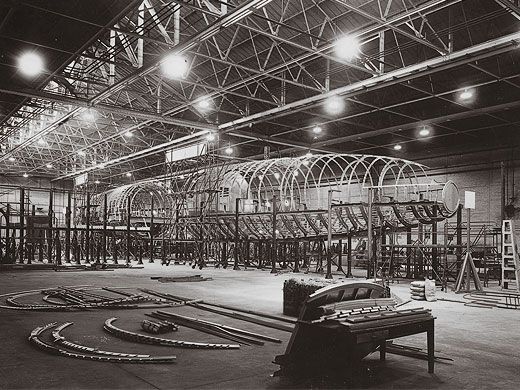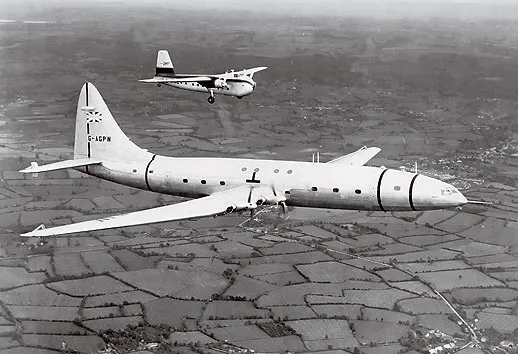Cancelled: Design by Committee
The Bristol Brabazon was big and it flew. Much more can’t be said.
/https://tf-cmsv2-smithsonianmag-media.s3.amazonaws.com/filer/Cancelled_Design_by_Committee_2_FLASH.jpg)
By the late 1940s, the only way to get more power from aircraft piston engines was to increase the complexity of the already overstressed, mega-cylinder radials. With simple and powerful turbojets becoming available, pistons were about to be relegated to aircraft much smaller than airliners.
Yet in 1943, government planners in England began to mull over a post-war superplane, a transatlantic airliner of gargantuan proportions. The Brabazon, to be built by Bristol, would be powered by eight Bristol Centauruses—at 2,650 horsepower each, the most powerful British piston engine available.
Baron Brabazon of Tara, for whom the giant was named, headed the committee that had outlined the parameters of the superliner. In 1909, as commoner John Moore-Brabazon, he was the first Englishman to fly a powered aircraft from English soil. Several months later, he proved that pigs could fly, carrying one aloft in a basket tied to a wing strut of his Short-built Wright biplane.
One of aviation’s enduring legends is that the Brabazon Committee was formed because a World War II concord between the United Kingdom and the United States had decreed that the United Kingdom would concentrate on building bombers while the United States would develop transports. Thus, the story goes, a nation that had been prevented from developing equivalents to the American DC-4s, -6s, Constellations, and Stratocruisers would need to play a long game of catch-up.
No such agreement existed. The United States developed sophisticated piston-engine airliners because American industry had started work on them (or their military predecessors) before World War II. The Brabazon Committee was an effort to create an air transport industry where none existed. “As early as 1937, Britain began to realize that the leaders of Imperial Airways had failed miserably in providing Britain with decent global and regional air service,” says aviation historian Richard Hallion. “Britain was simply paying the price for a pre-war philosophy that had stressed the exclusivity of upper-class air travel, where comfort was more important than speed and payload. The Brabazon Committee was intended to do one thing: prevent the U.S. from extending its air transport lead in the post-war world that it had developed between 1933 and 1939.”
When the Bristol Brabazon finally flew, in 1949, British newspapers heaped praise on “the queen of the skies, the largest landplane ever built,” overlooking the fact that the Convair B-36, which had an identical wingspan but was heavier and, with its turbojet-piston engine combo, more powerful than the Brabazon, had flown three years earlier. Convair would produce nearly 400 units; the initial order for Brabazons was 10, but only one was built. A second, the Mark II, to be powered by Bristol Proteus turboprop engines, was never finished.
Film of the Brabazon’s first flight shows why Graham White, an authority on aviation piston engines, ruefully calls the big Bristol “essentially a powered glider.” It lifts off, thrumming with the characteristic low-pitched growl of geared, contra-rotating propellers, and climbs out at a rate so flat that one fears it’s about to sink back onto the pastures of Gloucestershire.
At 230 feet, the Brabazon’s wings indeed had the span of a gigantic sailplane. Because an enormous amount of wing volume was needed to hold the fuel for a transatlantic range, Bristol engineers came up with a unique way to carry eight big radial engines within the most inboard portion of the wings, leaving the rest for fuel tanks. The Centauruses were “twinned”—two engines per pair of propellers—but rather than sandwiched on a common crankshaft, the engines were set side by side, each angling its driveshaft in toward an enormous central gearbox that drove the pair of contra-rotating propellers.
British Overseas Airways Corporation, which itself had no interest in buying the Brabazon, convinced planners that transatlantic travel would be the province of the wealthy and government travelers on unlimited expense accounts. Rather than filling the cabin with the 300 seats it could have accommodated—the fuselage was larger than a modern twin-engine wide-body—designers laid out the cabin with as few as 60 seats. The high-rent seats provided for each passenger roughly the space of two passenger cars’ interiors, to make the 12-hour trip (at the Mark II’s cruising speed of 330 mph) bearable. There was also talk of a movie theater and a cocktail bar and lounge.
Ultimately, Lord Brabazon again proved that a pig can fly, though not for long. In 1953, the sole Bristol Brabazon was scrapped, having flown 382 hours in testing and having never carried a single paying passenger.
Air & Space contributing editor Stephan Wilkinson and college pal and photographer Bruce McAllister are wrapping up a book collaboration, Skygirls: A Pictorial History of the Airline Stewardess. Wilkinson’s most recent story for Air & Space was “Cancelled: Too Hot to Handle,” on the McDonnell XP-67 (Dec. 2010/Jan. 2011).

